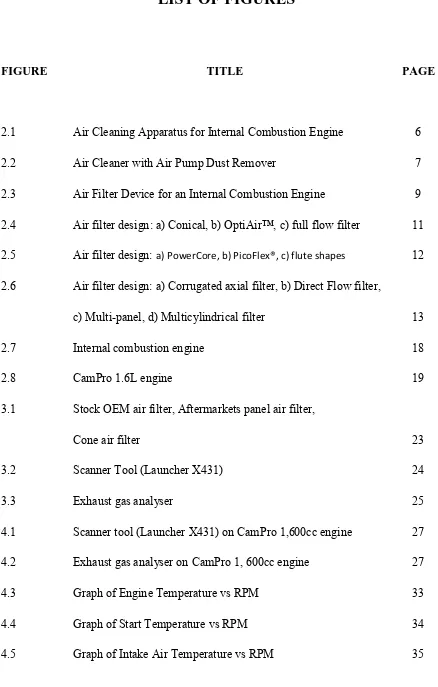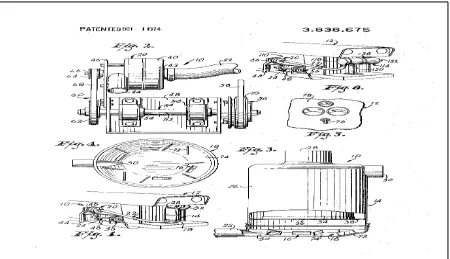UNIVERSITI TEKNIKAL MALAYSIA MELAKA
A STUDY OF THE PERFORMANCE OF CAMPRO 1, 600CC ENGINE
This report submitted in accordance with requirement of the Universiti Teknikal Malaysia Melaka (UTeM) for the Bachelor’s Degree in Mechanical Engineering Technology (Automotive Technology) (Department of Mechanical Engineering Technology) (Hons.)
By
SHAHRUL REEZA BIN SHAHRIN B071210221
901023075493
DECLARATION
I hereby, declared this report entitled “A STUDY OF THE PERFORMANCE OF CAMPRO 1,600CC ENGINE” is the results of my own research except as cited in references.
Signature : ………..
Author’s Name : SHAHRUL REEZA BIN SHAHRIN
APPROVAL
This report is submitted to the Faculty of Engineering Technology of UTeM as a partial fulfillment of the requirements for the degree of Bachelor of Engineering Technology (Bachelor of Engineering Technology Automotive) (Hons.). The member of the supervisory is as follow:
i
ii
ACKNOWLEDGEMENT
First of all, I would like to thank Allah SWT for giving me strength to complete this project successfully on time. Then I would like to express my deepest gratitude to my project supervisor, Mr. Ahmad Zainal Taufik Bin Zainal Ariffin who had giving me guidance, ideas and support for this project. It would be difficult to complete this project without his support and understanding.
iii
ABSTRACT
iv
ABSTRAK
vi 2.2.1 Air Cleaning Apparatus for Internal Combustion Engine 5
2.2.2 Air Cleaner with Air Pump Dust Remover 7 2.2.3 Air Filter Device for an Internal Combustion Engine 9
2.3 Design Trends of Air Filter 10
2.4.7 Depth Loading (multilayered felts, paper/felts etc.) 17
2.4.8 Deep Bed Filters 17
3.2 Approach towards Experimental Testing 23
3.3 Experimental Testing 24
3.3.1 Scanner Tool (Launcher X431) 24
vii
3.4 Experimental Analysis 25
CHAPTER 4: RESULT AND DISCUSSION
4.0 Introduction 26
4.1 Experimental Result 26
4.1.1 OEM Air Filter 28
4.1.2 3rd Party Air Filter 29
4.1.3 Cone Air Filter 31
4.2 Experimental Discussion 32
4.2.1 Scanner Tool (Launcher X431) 33
4.2.2 Exhaust Gas Analyzer 37
CHAPTER 5: CONCLUSION AND RECOMMENDATION
5.0 Introduction 42
5.1 Conclusion 42
5.2 Recommendation 43
viii
LIST OF TABLES
TABLE TITLE PAGE
2.1 Specification of CamPro engine 20
3.1 CamPro 1, 600cc specification 23
4.1 Scanner tool data for OEM air filter 28
4.2 Gas analyzer reading for OEM air filter at 900 RPM 28 4.3 Gas analyzer reading for OEM air filter at 3000 RPM 29
4.4 Scanner tool data for 3rd party air filter 29
4.5 Gas analyzer data for 3rd party air filter at 900 RPM 30 4.6 Gas analyzer data for 3rd party air filter at 3000 RPM 30
4.7 Scanner tool data for Cone air filter 31
ix 2.6 Air filter design: a) Corrugated axial filter, b) Direct Flow filter,
c) Multi-panel, d) Multicylindrical filter 13
2.7 Internal combustion engine 18
2.8 CamPro 1.6L engine 19
3.1 Stock OEM air filter, Aftermarkets panel air filter,
x
4.6 Graph of Manifold Pressure vs RPM 36
4.7 Graph of HC vs RPM 37
4.8 Graph of CO2 vs RPM 38
4.9 Graph of NOx vs RPM 39
4.10 Graph of CO vs RPM 39
xi
LIST OF ABBREVIATIONS
AFR - Air/fuel Ratio
CamPro - Cam Profiling
OEM - Original Equipment Manufacturer
cc - cubic centimeters
OBD - On-board Diagnostic
ICE - Internal Combustion Engine
UK - United Kingdom
IAFM - Intake Air-Fuel Module
DOHC - Dual-OverHead Camshaft
RPM - Revolution Per Minute
HC - Hydrocarbon
CO2 - Carbon Dioxide
NOx - Nitrogen Oxide
CO - Carbon Oxide
1
1.0 Background
Air filter is a device composed of fibrous materials which removes solid particulates such as dust, pollen, mould, and bacteria from the air. A chemical air filter consists of an absorbent or catalyst for the removal of airborne molecular contaminants such as volatile organic compounds or ozone. Air filters are used in applications where air quality is important, notably in building ventilation systems and in engines. Some buildings, as well as aircraft and other man-made environments (e.g., satellites and space shuttles) use foam, pleated paper, or spun fiberglass filter elements. Another method, air ionisers, use fibers or elements with a static electric charge, which attract dust particles. The air intakes of internal combustion engines and compressors tend to use either paper, foam, or cotton filters. Oil bath filters have fallen out of favour.
The air filter for internal combustion engine is used to prohibit the entry of foreign particles such as road dust, debris, etc. into the engine. This helps in the enhanced functionality of engines. It minimizes the emissions from vehicles and prevents the engine and its component from damages by foreign particles. It also will help in maintaining or significantly increase the performance of the engine by using a different type of air filter that are accessible in the aftermarkets. The market for automotive air filter is influenced by production trends in the automotive industry, emission norms, health safety regulations, buyer’s preferences, and lifestyle, whereas factors such as vehicle park, average miles driven, and the types of filter used influence the aftermarket demand for air filters.
2
1.1 Problem Statement
There are various type and brands of conventional cars nowadays to choose, from the new one to buy or which are already on the road. One of the issue for regular drivers is to maintain the performance and fuel emissions of the engine car. There are so many parts which will affect the performance of the engine. One of the parts is the air filters. Air filter is one of the variable for an engine car performance, whether a good or bad air filter will resulting in the increase or decrease in performance of the engine car. There are so many type of air filter in the aftermarket which differentiate between the design, materials use and type. The issue with engine air filter is, it is the less likely parts to be maintain regularly. Conventional drivers don’t usually change the air filter even when it needs to. In some cases, the drivers is confuse whether to change the engine air filter to just the standard OEM air filter or using aftermarket air filter to use with the engine car. This report is done to verify the importance of air filters to the engine car performance and to identify which air filters is better, the OEM air filter or aftermarkets air filters.
1.2 Objective
The objective of this project are:
1. To study and monitor the onboard computer of an engine in respect to the engine performance.
2. To determine the fuel emissions of the engine.
3. To decide which air filters from the selected air filter is best to be use to maintain/maximize the engine.
1.3 Project Scope
3
1.4 Organization of Research
4
2.0 Introduction
The aim of this chapter is to provide all the information about the air filter for internal combustion engine. What will be the effect on the performance of the internal combustion engine when using different type of air filter? Which air filter is better, stock OEM air filter or the aftermarket air filter in respond to the engine performance? The air filter for the internal combustion engine will be discussed thoroughly in this chapter. Various sources including journal, thesis, reference books and literature reviews have been investigated and revised in writing this chapter.
2.1 Air Filter in Automotive
Air filters are the key components for automobiles, and evolves with developments in the automotive industry. Taking the automotive industry as a whole it must be observed that the air filtration applications around road vehicles have increased and are still increasing. Besides filters for the crankcase ventilation and transmission filters a whole new range of filter systems in the vehicle has developed. This is mainly due to the so-called On-board diagnostics (OBD) II standard and driven by the trend to zero emission vehicles. A multitude of sensors on the cars, which can be very sensitive to contamination (with particles and gases) and in many cases have to be protected, require specific air filters. Today there are 30 to 40 different filter applications around the automobile to be found. The technological performance requirements of the majority of these products are usually more straightforward and are often but vaguely
5 defined. The definition of performance profiles does not yet follow standardized filter tests but are negotiated. Further by proper maintenance can help vehicles perform as designed, positively affecting fuel economy, emissions, and overall drive ability. Automotive air filters are classified into two categories-engine/intake air filter and cabin air filter. The intake air filter is used to prohibit the entry of foreign particles such as road dust, debris, etc. into the engine. This helps in the enhanced functionality of engines. It minimizes the emissions from vehicles and prevents the engine and its components from damages caused by foreign particles. Cabin air filters are the new types of air filters, which are specifically designed for the vehicle's cabin air filtration.
2.2 History of Air Filter
The internal combustion engine air filter prevents abrasive particulate matter from entering the engine's cylinders, where it would cause mechanical wear and oil contamination. Most fuel injected vehicles use a pleated paper filter element in the form of a flat panel. This filter is usually placed inside a plastic box connected to the throttle body with ductwork. Older vehicles that use carburettors or throttle body fuel injection typically use a cylindrical air filter, usually a few inches high and between 6 inches (150 mm) and 16 inches (410 mm) in diameter. This is positioned above the carburettor or throttle body, usually in a metal or plastic container which may incorporate ducting to provide cool and/or warm inlet air, and secured with a metal or plastic lid. The overall unit (filter and housing together) is called the air cleaner.
2.2.1 Air Cleaning Apparatus for Internal Combustion Engine
6 According to the invention Engine (Mathias Streete Charles, 1965), a hopper for powder or granular material is provided with a gas operated ejector for removing the powder or granular material from the container. Conveniently the ejector may be arranged to act continuously during the operation of a filter or dust extractor. Thus, where the filter is used to supply clean air to a supercharged internal combustion engine, the ejector may be fed continuously with a stream of air bled from the high-pressure side of the supercharger.
Where the filter is a cyclone separator used to supply an internal combustion engine, the pressure in the hopper is depressed below atmospheric pressure by the engine, or supercharger, suction. Therefore, the ejector system, or jet, must be throttled to produce a depression sufficiently below the hopper pressure to entrain the dust. Beyond the point at which the dust is entrained, the dust laden stream is expanded to approximately atmospheric pressure to enable the dust to be deposited. One form of ejector that is suitable for such operation comprises a venturi tube with a coaxial tapered nozzle which delivers a jet into the throat of the venturi tube while the dust is entrained by the jet in the convergent part of the venturi tube.
7 Based on the previous Figure 2.1:
FIGURE 1 is a section (taken on the line I-I in FIG 2) of a cyclone dust extractor diagrammatically shown connected to an internal combustion engine.
FIGURE 2 is a section on the line II-II in FIGURE 1.
2.2.2 Air Cleaner with Air Pump Dust Remover
The Air Cleaner with Air Pump Dust Remover is invented and patented by N Schaeffer on Oct 1, 1974. This invention relates to an air cleaner apparatus as is commonly used in connection with an internal combustion engine and which is intended for the purpose of removing foreign particles in-the form of dust, trash and the like from the air that is normally aspirated into the engine for combustion purposes. The drawing of the invented is as Figure 2.2 below:
8 Based on Figure 2.2:
FIG. 1 is a fragmentary perspective view of a combination air cleaning and purging apparatus made pursuant to the present invention as adapted for use with the engine of an agricultural or industrial tractor;
FIG. 2 is an enlarged, fragmentary, side elevational view of the air pump portion of the apparatus along with its associated drive and clutching mechanism;
FIG. 3 is an enlarged, fragmentary, elevational view of a dry element type air filtering device used in connection with the combination air cleaning and purging apparatus, a portion of the casing being broken away to reveal details of construction;
FIG. 4 is a plan view of the collector cap portion of the air filtering device showing the randomly placed, upright vane structure provided for creating an air turbulence during purging of the collector cap;
FIG. 5 is a fragmentary view of an operators control panel having a switch mounted thereon for selectively actuating the air pump; and
FIG. 6 is a fragmentary perspective view of an alternate form of the air cleaning and purging apparatus in which the air filter device is disposed horizontally.
9 2.2.3 Air Filter Device for an Internal Combustion Engine
The invention relates to an air filter device for an internal combustion engine of the type including a charge-air compressor, a charge-air cooler, a water-air heat exchanger and a motor-driven blower with a blower hood, invented and patented by Stefan Bopp on Feb 2, 1993 as shown in Figure 2.3.
Figure 2.3: Air Filter Device for an Internal Combustion Engine (Stefan Bopp, 1993)
Based on the above Figure 2.3:
FIG. 1 is a schematic view which shows the subject-matter of the invention with an additional exhaust-air line constructed as a bypass line;
10 FIG. 3 is a schematic view showing yet another preferred embodiment of the invention.
This invention of air filter device is disclosed which includes a dry air filter and a dust precipitator for an internal-combustion engine, having a dust extraction blower in a dust exhaust-air line leading away from the dust precipitator. In order to maintain perfect operation of the internal-combustion engine, in addition to the dust exhaust-air line there is provided an additional exhaust-air line which is connected to the intake side of the motor-driven blower and has a shut-off element which opens in the event of failure of the dust extraction blower (Stefan Bopp, 1993).
2.3 Design Trends of Air Filter
According to (Jaroszczyk, Byron A. Pardue, Christopher E. Holm, 2004), the need for either reduced filter size for a stated airflow rate or increased flow rate for an air filter with a size comparable to a conventional panel or cylindrical filter design resulted in the development of in-line fluted or pleated element air filters. In the designs, the entire volume of filter housing accommodates filter media. Furthermore, new filter media with high permeability enabled size reduction of the air filter even further. Panel and cylindrical air filters still dominate the market. These designs require large housing volumes with relatively small inlets and outlets. Flow turbulences that usually develop in the transition, sudden contraction or sudden expansion areas are sources of increased pressure drop. Turbulence can be reduced by incorporating media into the empty spaces.



